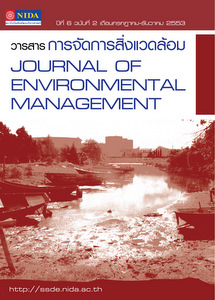การประเมินผลการปฏิบัติตามมาตรการจากการประเมินผลกระทบสิ่งแวดล้อมของกระทรวงคมนาคม/Assessing the Implementation of Environmental Impact Assessment Measures: A Case Study of Ministry of Transport
บทคัดย่อ
การวิจัยครั้งนี้มีวัตถุประสงค์เพื่อศึกษาผลการปฏิบัติตามมาตรการจากการ ประเมินผลกระทบสิ่งแวดล้อม และปัจจัยที่มีผลต่อความสำเร็จในการสร้างความร่วมมือของหน่วยงานสังกัด กระทรวงคมนาคม ได้แก่ กรมการบินพลเรือน กรมเจ้าท่า กรมทางหลวง กรมทางหลวงชนบท การรถไฟแห่งประเทศไทย การทางพิเศษแห่งประเทศไทย การรถไฟฟ้าขนส่งมวลชนแห่งประเทศไทย และการท่าเรือแห่งประเทศไทย ในการปฏิบัติตามมาตรการดังกล่าวของโครงการที่ต้องจัดทำรายงานการวิเคราะห์ผล กระทบสิ่งแวดล้อม ทั้งด้านผลผลิตและผลลัพธ์ โดยพิจารณาจากการตอบแบบสอบถามของเจ้าหน้าที่ระดับปฏิบัติและการสัมภาษณ์แบบ เจาะลึกของเจ้าหน้าที่ระดับบริหาร พบว่า มีโครงการที่จัดส่งรายงานผลการปฏิบัติตามมาตรการ ประมาณร้อยละ 20 ของจำนวนโครงการทั้งหมด โดยกลุ่มตัวอย่างส่วนใหญ่มีการให้ความร่วมมือแบบตั้งใจทำตามแต่ทำตามไม่ สำเร็จ และมีระดับความคิดเห็นด้วยค่อนข้างมากต่อปัจจัยที่ทำให้เกิดความร่วมมือของ หน่วยงานสังกัดกระทรวงคมนาคม ในการปฏิบัติตามมาตรการด้านสิ่งแวดล้อม โดยเรียงลำดับได้ดังนี้ 1. การสนับสนุนจากผู้บริหารหน่วยงาน 2. ลักษณะโครงสร้างของหน่วยงาน 3. การกำหนดภารกิจและการมอบหมายงาน, ความพร้อมของบุคลากร, การจัดจ้างบริษัทที่ปรึกษาในการปฏิบัติงาน 4. การติดตามผลการปฏิบัติงาน 5. ความพร้อมของงบประมาณ 6. การกำหนดบทลงโทษและการให้รางวัล และ 7. สภาพแวดล้อมทางการเมือง เศรษฐกิจ สังคม วัฒนธรรม และเทคโนโลยี
The objectives of this study were to evaluate the implementation of environmental impact assessment (EIA) and to explore the factors related to success in building collaboration among goverment offices in the Transport Ministry. Specifically, this study assessed both output and outcome of EIA implementation in mass-transporting projects such as expressways, sky-trains, railways, highways, airports and commercialpiers. Data collection was based on in-depth interview and questionnaire survey of executive and implementing officials, respectively. The data revealed that only 20% of the mass-transporting projects had implemented and followed up mitigation measures in EIA reports. Moreover, the respondents strongly agreed on factors that could facilitate collaboration among offices in the Transport Ministry. These factors, ranked by order of importance, are as follows: i) support from executives; ii)organizational structure; iii) mission and task assignment, staff capability, and consultant hiring; iv) monitoring system; v) sufficient fiscal budget; vi) punishmentand reward systems; and vii) political, socio-economic, cultural and technological environments.



